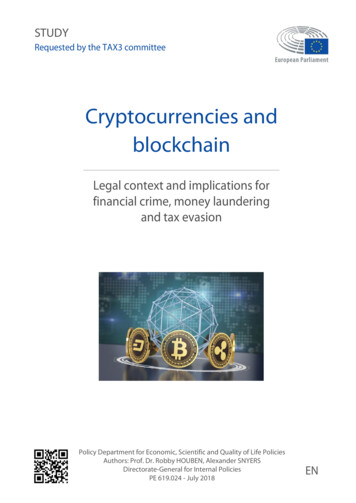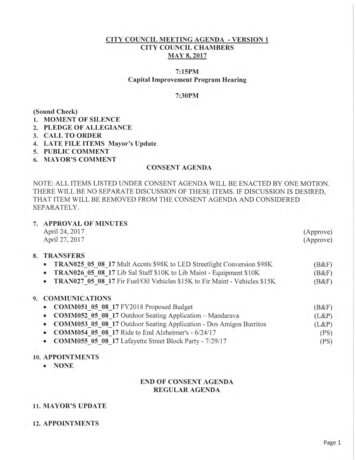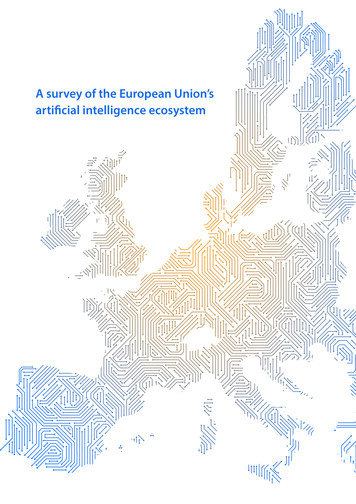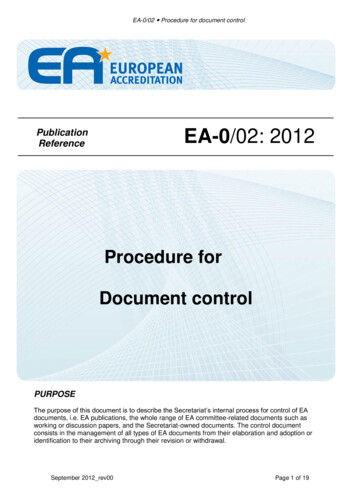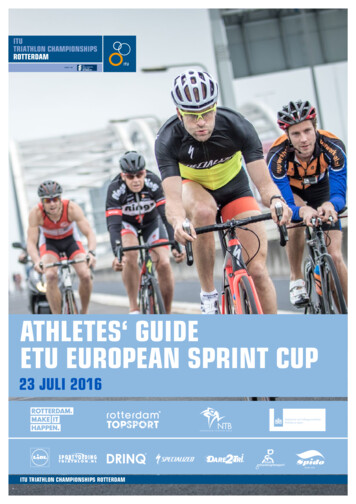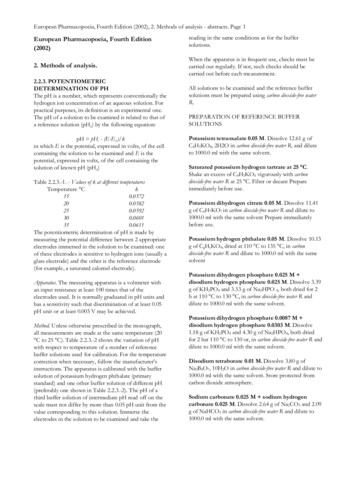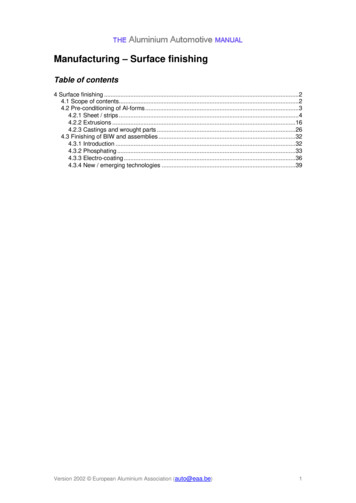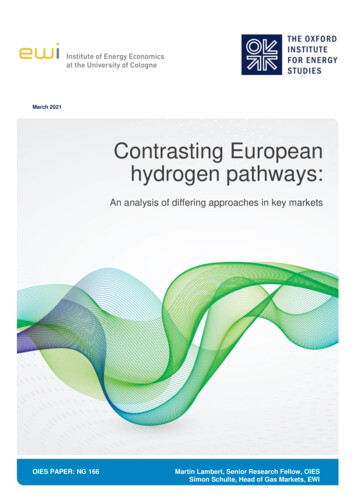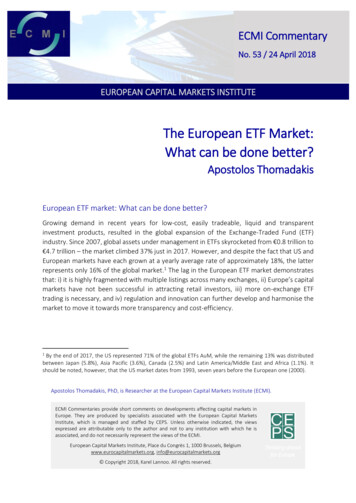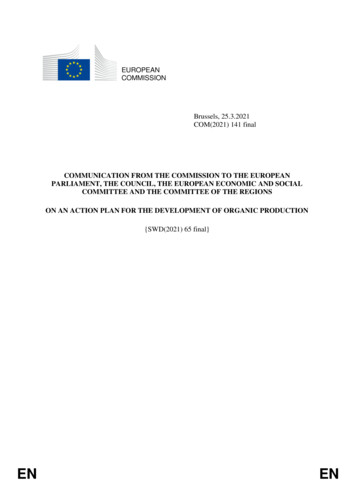
Transcription
EUROPEANCOMMISSIONBrussels, 25.3.2021COM(2021) 141 finalCOMMUNICATION FROM THE COMMISSION TO THE EUROPEANPARLIAMENT, THE COUNCIL, THE EUROPEAN ECONOMIC AND SOCIALCOMMITTEE AND THE COMMITTEE OF THE REGIONSON AN ACTION PLAN FOR THE DEVELOPMENT OF ORGANIC PRODUCTION{SWD(2021) 65 final}ENEN
INTRODUCTION AND BACKGROUNDThe European Green Deal is at the centre of theCommission’s policy agenda. Its prime objective is asustainable, climate-neutral Europe by 2050, acting asa vehicle for investment and growth1.KEY FIGURES: The areaunder organic farming hasincreased by almost 66% inthe last 10 years - from 8.3million hectares in 2009 to13.8 million hectares in 2019.It currently accounts for 8.5%of the EU’s total ‘utilisedagriculturalarea’.Thisincrease in area has beenmatched by a substantialincrease in retail sales. Thesehave doubled in value in thelast10years,fromapproximately EUR 18 billionin 2010 to more than EUR 41billion in 2019.The Green Deal emphasizes that it is ‘key’ to managethe transition towards a more sustainable food system,in particular strengthening the farmer’s efforts to tackleclimate change, protect the environment and preservebiodiversity’. The farming community has an essentialrole to play in the achievement of these objectives.Farmers are at the forefront of the consequences ofclimate change and biodiversity loss whileunsustainable agricultural practices remain a majordriver of biodiversity loss. Organic farmers are thepioneers of the sustainable agriculture of the future.They open ways in greening agriculture and innovativeproduction techniques that are friendly to theenvironment, promote circularity and animal welfare.The organic logo reflects the farmers’ commitments to these high production standardsand consumers are assured that the product has been made according to very specific andstringent sustainability rules. Even more importantly, organic farming brings much morenature into our fields and it makes farmers more resilient to economic changes as well asto those brought upon them by increasingly erratic nature and climate.That is why the 2030 Biodiversity Strategy2 and the Farm to Fork Strategy3 - togetherwith the upcoming zero pollution action plan on air, water and soil – set out concreteactions covering the full chain from food production to consumption, actions that alsoencompass international cooperation on sustainable food systems. These strategies aim toreconcile food production with environmental protection while spurring investment andsustainable production, an objective that the Commission will seek to promote within thecontext of the Sustainable Development Goals. In addition, the Farm to Fork Strategyannounced the EU carbon farming initiative for this year, which aims, within the contextof the climate pact, to reward farmers for the verified provision of ecosystem restoration,emission reduction and carbon sequestration services.The COVID-19 pandemic has meanwhile produced an unprecedented challenge for theEU. It is having a far-reaching impact on the economy, people’s health and food systems.The EU’s response comprises a recovery plan supported by the ‘Next Generation EU’instrument and the new multiannual financial framework. ‘Next Generation EU’ fundscould be used to support investments in the organic sector, provided that they meet the1The legislative proposal COM/2018/392 final - 2018/0216 (COD), the future common agriculturalpolicy (CAP) also highlights the beneficial role of organic farming and offers support to it throughdifferent mechanisms.2COM(2020) 380 final.3COM(2020) 381 final.1
relevant conditions and objectives. Europe’s recovery from the COVID-19 crisisprovides an early opportunity to make the Green Deal a reality, by providing a broadplatform for sustainable production and consumption patterns, including in the field ofagriculture and aquaculture.Organic farming plays a central role in the achievement of Europe’s recovery, whichshould be green and digital, through bolstering rural incomes. It generally involvesshorter supply chains and provides opportunities for small farmers, enhanced by the newprovisions introduced in Regulation 2018/848 on organic production.4 This regulationaims to modernise the sector and harmonise the rules, providing a stable regulatoryframework.There is broad consensus on the key role of organic production and consumption. In itsFarm to Fork Strategy and the Biodiversity Strategy, the Commission has defined theobjective of ‘at least 25% of the EU’s agricultural land under organic farming and asignificant increase in organic aquaculture by 2030’. In its resolution of 15 January 2020on the European Green Deal, the European Parliament has highlighted that agriculturehas the potential to help the EU reduce its emissions through sustainable practices, suchas organic farming.5 In its conclusions of 19 October 2020 on the Farm to Fork strategy,6the Council emphasized the role of organics in a sustainable food system. At the sametime, people across the EU endorse sustainable farming and food production, and publicawareness of the EU organic logo has increased markedly, as confirmed byEurobarometer special report 5047.This is why the Commission is putting forward this action plan for organic farming. Itbuilds up on the action plan for the period 2014-2020, which already addressed some ofthe problems identified by the review of the EU organic policy that resulted in theadoption of Regulation (EU) 2018/848 on organic farming. All of the 18 actions in the2014-2020 have been fully implemented. Major non-regulatory achievements include theroll-out of the electronic Certificate of Inspection (E-CoI) in Traces, which has improvedthe traceability and thus also integrity of organic products, and increased the informationon organic imports into the EU; specific funding for research and innovation on organicsin the EU Research and Innovation Framework Programmes; and the inclusion oforganics into ‘green public procurement’.The new action plan (2021 – 2027) also takes into account the outcome of the publicconsultation held between September and November 2020, which confirmed strongsupport for the action plan and its proposed actions from both stakeholders and thebroader public.Current projections predict a remarkable growth of the organic sector during this decade.Even if we continue doing just what we are doing, the share of organic agriculture4Regulation (EU) 2018/848 of the European Parliament and of the Council of 30 May 2018 on organicproduction and labelling of organic products and repealing Council Regulation (EC) No 834/2007.5European Parliament resolution of 15 January 2020 on the ent/TA-9-2020-0005 .7In this Eurobarometer special report, 56% of those surveyed said they were aware of the organics logo.2toForkGreenDeal:strategy:
should, according to some sources, reach between 15% and 18% of agricultural land by20308. The 25% target significantly increases our ambition. This action plan aims toencourage a marked increase of the share of organic farming in the EU, throughencouraging farmers to convert to organic farming, and to expand the accessibility oforganic food to close the gap between a business-as-usual growth curve and the “extraeffort” necessary to reach a 25% target by 2030.European citizens enjoy safe, topquality food. However, for decades,the share of household expenditure onfood has been decreasing and loweringfood prices have seen farmer incomesstagnate. Organic farming is morecostly as organic farmers work in amore extensive way and use naturalprocesses and substances, withoutusing synthetic products, and yields arelower. But organic farmers often enjoybetter incomes as organic products areusually sold at higher prices than conventional ones, while consumers value thecontribution to the environment made by organic farming.KEY BENEFITS: Land farmed organicallyhas about 30% more biodiversity than landfarmed conventionally. Organic farming is,for instance, beneficial to pollinators.Organic farmers are not allowed to usesynthetic fertilisers and may only use alimited range of chemical pesticides. Inaddition, the use of GMOs and ionisingradiation is prohibited and the use ofantibiotics is severely restricted.By integrating organic products into school meals and workplace canteens through publicprocurement, into the hospitality sector through incentives and visibility, intosupermarkets through promotion campaigns, and into everyday home cooking, moreorganic food will become accessible to more European citizens. There is also a need totackle the accessibility and affordability of organic food to help increase access toorganic food for low-income families. The action plan also aims to support farmers inconverting to organic production, by boosting education and training opportunities, bysupporting the market for organic products and in parallel identifying relevant incentives.Organic farming should be a model to follow. It is not the only sustainable farmingsystem but until carbon farming is fully rolled out, it is for now the only system whichhas been recognised by a robust certification method. As such, it should lead by exampleon the path to more sustainable farming practices, a better use of renewable resources,higher animal welfare standards, and higher incomes for farmers. Organic farming canalso boost social sustainability in various ways and support the development of ruralareas, in line with the upcoming Long-term vision for rural areas, as well as that ofcoastal areas. It can provide possibilities for young farmers and help foster equal accessand equal income between women and men in the sector.9 Studies10 show that organicfarming offers women farm entrepreneurs an easier entry-point than the conventionalsector. Organic farming has to inspire conventional farming and lead the way.8Eurostat and HIS roduct/page/LFST R ERGAU custom oduct/page/ILC DI17 custom 41629410andThe role of funding under the common agricultural policy (CAP) for women in /etudes/STUD/2015/536466/IPOL STU(2015)536466 EN.pdf.3
In December 2020, the Commission published recommendations11 to Member States ontheir future CAP strategic plans. These recommendations address economic,environmental and social challenges of European agriculture and rural areas, focusing onthe European Green Deal targets, including the target of 25% of agricultural land underorganic farming by 2030. Member States are therefore invited to set national values intheir CAP strategic plans for these Green Deal targets. Based on European averages andtrends, Member States should focus on increasing the organic area by defining targetpercentages or encouraging positive trends. When drafting their CAP national strategicplans, Member States will be asked to respond to the aforementioned recommendations.As the extent of organic production and consumption differs significantly betweenMember States – the share of agricultural land under organic farming ranges from a lowof 0.5% to a high of more than 25% - it is crucial for each Member State to develop assoon as possible its own national strategy on organic farming, drawing on acomprehensive analysis of the sector and with related actions, incentives, cleardeadlines and national objectives. All Member States should explain how they intendto contribute to the EU-wide target by setting a national value for the share of the areaunder organic farming by 2030, bearing in mind their different starting points. To ensurethe success of their national organic action plans, Member States should buildappropriate capacity to implement them. The Commission will monitor the progress ofMember States towards their national targets, providing the Commission and MemberStates with the opportunity to discuss the implementation of the proposed actions, andproviding guidance on necessary and relevant adjustments.Concerning aquaculture, the new Strategic Guidelines for the sustainable developmentof EU aquaculture to be adopted by the Commission in spring 2021 will promote organicaquaculture. In addition, the Commission encourages EU Member States to include theincrease of organic aquaculture among the objectives of their reviewed Multi-annualNational Strategic Plans for aquaculture. Furthermore, the Commission staff workingdocument on a sea basin perspective to guide the European Maritime and Fisheries Fund(EMFF) programming stipulates12 that the EMFF (future European Maritime, Fisheriesand Aquaculture Fund, EMFAF) should be used to promote sustainable aquaculturepractices such as organic production.The action plan is organised along three axes that accommodate the structure of the foodsupply chain (production, processing, and retailers and consumers). To support positivedevelopments in the organic sector and to maintain a balanced and profitable market fororganic operators, it is crucial to boost the overall demand for organic products. Agrowing consumption of organic products is vital to encourage farmers to convert toorganics (Axis 1). Further incentives for production are also needed to meet the target of25% of the utilised agricultural area under organic practices and a significant increase oforganic aquaculture by 2030 (Axis 2). Finally, there is a need to further improve theorganic sector’s contribution to sustainability and environmental challenges (Axis 3).11COM(2020) 846 final.12Commission staff working document on Regional Sea Basin Analyses – Regional challenges inachieving the objectives of the Common Fisheries Policy – A Sea Basin perspective to guide EMFFProgramming (SWD(2020) 206 final).4
Apart from continuing some of the existing successful actions, this action plan a
has been recognised by a robust certification method. As such, it should lead by example on the path to more sustainable farming practices, a better use of renewable resources, higher animal welfare standards, and higher incomes for farmers. Organic farming can also boost social sustainability in various ways and support the development of rural
